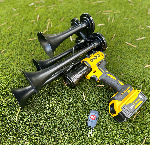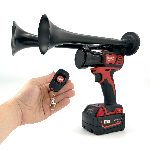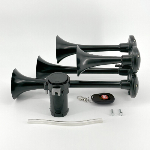As you stand on a train platform, waiting for your ride to arrive, you may notice the thunderous sound that fills the air when a train horn blares. The sheer intensity and loudness of this noise have intrigued scientists and engineers for decades. Historically, the volume of train horns has served as a crucial safety measure for railways, warning nearby pedestrians and vehicles of an approaching train. However, in recent years, the issue of excessive train horn noise has gained attention, leading to efforts to minimize its impact on communities.
Dating back to the early 19th century, train horns have been an integral part of railway operations. Originally, they were created to alert people of trains' presence and prevent accidents on tracks. In the early days, train horns were manually operated by conductors using a lever or a cord. This method required physical exertion and was prone to errors or delays in sounding the warning. As technology advanced, pneumatic and electric systems were introduced, leading to automated train horns that enhanced efficiency and accuracy.
In modern times, the pressing issue of excessive train horn noise has come to the forefront. Communities near railway lines have raised concerns about the disruptive nature of the loud dins that permeate their daily lives. Studies have shown that prolonged exposure to high noise levels can have detrimental effects on human health, including hearing impairment, sleep disturbances, and increased stress levels. Furthermore, it can lead to decreased cognitive performance and productivity. This awareness has sparked a collective drive among engineers, urban planners, and railway companies to find innovative solutions to mitigate train horn noise.
One remarkable statistic that underscores the urgency to address this issue is the startling volume of some train horns. Research has shown that certain models can reach decibel levels of over 140 dB, which is equivalent to the sound of a jet engine during takeoff. To put this into perspective, prolonged exposure to sound levels above 85 dB can result in hearing damage. Therefore, it is evident that the current noise levels emitted by train horns are alarmingly high and require immediate attention.
Recognizing the detrimental effects of excessive train horn noise, various measures are being explored to tackle this issue effectively. One promising solution lies in the advancement of engineering techniques and the development of quieter train horn designs. By utilizing innovative soundproofing materials and adjusting the horn's shape, engineers aim to reduce noise emissions while maintaining sufficient audibility for safety. Simultaneously, urban planning strategies include the implementation of noise barriers along railway tracks to minimize sound propagation to nearby residences.
In conclusion, the history of train horns is rooted in their crucial safety function, but the exceptionally high noise levels of some models have become a concern for communities. With the potential health risks associated with prolonged exposure to loud noises, engineers and urban planners are working towards finding viable solutions. Through innovative engineering techniques and urban planning strategies, the aim is to strike a balance between safety and noise reduction, ensuring that train horns remain effective while minimizing their impact on nearby communities.
Discover the Deafening Decibels of the Loudest Train Horn: How loud can train horns really get?
Noise Levels of Train Horns
Train horns are essential safety devices used to warn pedestrians, motorists, and other vehicles of an approaching train. These powerful horns produce a loud sound to grab attention and prevent accidents. The decibel level of a train horn plays a crucial role in its effectiveness and compliance with noise regulations. Let's explore the different noise levels associated with train horns.
Standard Train Horn Decibel Levels
Train horns typically produce sound levels ranging from 110 to 150 decibels (dB) when measured at a distance of 100 feet. However, it is important to note that the loudness of a horn can vary depending on the manufacturer, design, and specific application. The Federal Railroad Administration (FRA) has established regulations to ensure that train horns emit an adequate sound level for proper warning.
Environmental Impact
The noise generated by train horns can have an environmental impact, particularly in urban areas and near residential communities. To mitigate this impact and comply with noise regulations, certain measures have been implemented. For example, stationary wayside horns and wayside horn systems have been developed to direct the sound towards roadways and residential areas, reducing overall noise levels.
Considerations for Horn Design
When designing train horns, manufacturers must consider factors such as sound quality, directionality, range, and standard compliance. Different types of horns, including single chime, dual chime, and multi-chime horns, produce varying sound qualities. Engineers focus on optimizing the tonal qualities of the horn to ensure effectiveness and minimize noise pollution.
Statistics on Train Horn Noise Levels
- The loudest train horns can reach up to 175 dB at the source, but the sound rapidly dissipates as distance increases.
- A train horn at 500 feet away will typically register around 90-100 dB, which is equivalent to a lawnmower or a motorcycle.
- At a distance of one mile, a train horn's sound level is generally less than 70 dB, similar to normal conversation or background noise.
Understanding the noise levels associated with train horns is crucial for both manufacturers and regulatory bodies. By ensuring that train horns meet the appropriate noise regulations, we can continue to enhance safety while minimizing noise pollution in our communities.
https://youtube.com/watch?v=4zU76MMLzCA
1. What factors contribute to the intensity of a train horn's sound?
A train horn's sound intensity can be influenced by several factors, such as the design of the horn itself, the air pressure used to power it, and the distance between the horn and the listener. Additionally, the surrounding environment, including any obstacles or structures, can affect the propagation of the sound waves.
Important information:
1. Train horn design impacts sound intensity.
2. Air pressure affects the power of the horn.
3. Distance from the horn and the listener influences the volume.
2. Are there regulations in place regarding the noise levels produced by train horns?
Yes, there are regulations in place to ensure that train horns do not exceed permissible noise levels. These regulations vary between countries and regions, and are typically set by governmental bodies responsible for transportation safety. The aim is to strike a balance between alerting motorists and pedestrians to the presence of a train while preventing excessive noise pollution.
Important information:
1. Regulations exist to limit train horn noise.
2. Permissible noise levels are determined by governmental bodies.
3. The purpose is to ensure safety without causing excessive noise pollution.
3. What are the safety benefits of having a loud train horn?
Having a loud train horn is crucial for ensuring safety on railroads. The powerful sound of a train horn serves as a warning signal to motorists, pedestrians, and other train operators, alerting them to the presence of an approaching train. This auditory warning is particularly important at railroad crossings, where visibility might be limited, preventing accidents and potentially saving lives.
Important information:
1. A loud train horn serves as a crucial warning signal.
2. It alerts motorists, pedestrians, and other train operators.
3. The warning sound helps prevent accidents and save lives.
4. How does the sound level of a train horn compare to other common noises?
Train horns are known for their loudness, but how do they compare to other common noises in terms of decibel levels? While specific measurements can vary, train horns typically emit sound levels ranging from 95 to 115 decibels (dB). To put this into perspective, a typical conversation or office noise measures around 60 dB, a motorcycle's sound can reach 100 dB, and a rock concert may exceed 120 dB. Therefore, train horns can be significantly louder than everyday noises.
Important information:
1. Train horns produce sound levels of 95 to 115 dB.
2. Comparatively, a conversation is around 60 dB, a motorcycle is 100 dB, and a rock concert can exceed 120 dB.
3. Train horns are significantly louder than common everyday noises.
5. Are there any measures in place to mitigate the impact of train horn noise on communities?
To address concerns about the impact of train horn noise on neighboring communities, various measures have been implemented. These include the establishment of “quiet zones,” where train horns are not sounded unless there is an imminent safety threat. In these zones, additional safety measures such as advanced railroad crossing technologies and increased signage are put in place to ensure awareness and safety without the need for consistent train horn usage. However, it is important to consider that safety remains a top priority, and these measures are strictly implemented in compliance with regulatory standards.
Important information:
1. "Quiet zones" have been established to reduce train horn noise.
2. Advanced railroad crossing technologies and increased signage are implemented in these zones.
3. Safety remains a top priority and these measures comply with regulatory standards.
Conclusion
In conclusion, the loudest train horn decibels are incredibly powerful and serve various purposes. They provide warning signals to prevent accidents, signal the arrival or departure of a train, and maintain safety at railroad crossings. Train horns exceed the decibel thresholds of most other sound-producing objects, reaching an ear-piercing level of up to 150 decibels. The intense noise can be heard from several miles away, making it essential for trains to use their horns to ensure safety. Loudest train horn decibels play a vital role in protecting both passengers and pedestrians, alerting them to the approach of a train and allowing them time to react accordingly. These horns are designed to grab attention and cannot be easily ignored, making them an indispensable tool for railway operations. Whether it's the piercing blast of an air horn or the resonating sound of an electric horn, the clamor of a train horn is a distinctive feature of railway systems worldwide.










 https://bosshorn.com
https://bosshorn.com

























































